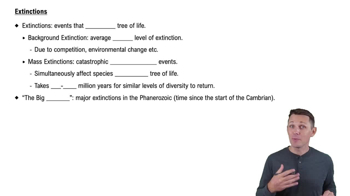Table of contents
- 1. Introduction to Biology2h 40m
- 2. Chemistry3h 40m
- 3. Water1h 26m
- 4. Biomolecules2h 23m
- 5. Cell Components2h 26m
- 6. The Membrane2h 31m
- 7. Energy and Metabolism2h 0m
- 8. Respiration2h 40m
- 9. Photosynthesis2h 49m
- 10. Cell Signaling59m
- 11. Cell Division2h 47m
- 12. Meiosis2h 0m
- 13. Mendelian Genetics4h 41m
- Introduction to Mendel's Experiments7m
- Genotype vs. Phenotype17m
- Punnett Squares13m
- Mendel's Experiments26m
- Mendel's Laws18m
- Monohybrid Crosses16m
- Test Crosses14m
- Dihybrid Crosses20m
- Punnett Square Probability26m
- Incomplete Dominance vs. Codominance20m
- Epistasis7m
- Non-Mendelian Genetics12m
- Pedigrees6m
- Autosomal Inheritance21m
- Sex-Linked Inheritance43m
- X-Inactivation9m
- 14. DNA Synthesis2h 27m
- 15. Gene Expression3h 20m
- 16. Regulation of Expression3h 31m
- Introduction to Regulation of Gene Expression13m
- Prokaryotic Gene Regulation via Operons27m
- The Lac Operon21m
- Glucose's Impact on Lac Operon25m
- The Trp Operon20m
- Review of the Lac Operon & Trp Operon11m
- Introduction to Eukaryotic Gene Regulation9m
- Eukaryotic Chromatin Modifications16m
- Eukaryotic Transcriptional Control22m
- Eukaryotic Post-Transcriptional Regulation28m
- Eukaryotic Post-Translational Regulation13m
- 17. Viruses37m
- 18. Biotechnology2h 58m
- 19. Genomics17m
- 20. Development1h 5m
- 21. Evolution3h 1m
- 22. Evolution of Populations3h 52m
- 23. Speciation1h 37m
- 24. History of Life on Earth2h 6m
- 25. Phylogeny2h 31m
- 26. Prokaryotes4h 59m
- 27. Protists1h 12m
- 28. Plants1h 22m
- 29. Fungi36m
- 30. Overview of Animals34m
- 31. Invertebrates1h 2m
- 32. Vertebrates50m
- 33. Plant Anatomy1h 3m
- 34. Vascular Plant Transport2m
- 35. Soil37m
- 36. Plant Reproduction47m
- 37. Plant Sensation and Response1h 9m
- 38. Animal Form and Function1h 19m
- 39. Digestive System10m
- 40. Circulatory System1h 57m
- 41. Immune System1h 12m
- 42. Osmoregulation and Excretion50m
- 43. Endocrine System4m
- 44. Animal Reproduction2m
- 45. Nervous System55m
- 46. Sensory Systems46m
- 47. Muscle Systems23m
- 48. Ecology3h 11m
- Introduction to Ecology20m
- Biogeography14m
- Earth's Climate Patterns50m
- Introduction to Terrestrial Biomes10m
- Terrestrial Biomes: Near Equator13m
- Terrestrial Biomes: Temperate Regions10m
- Terrestrial Biomes: Northern Regions15m
- Introduction to Aquatic Biomes27m
- Freshwater Aquatic Biomes14m
- Marine Aquatic Biomes13m
- 49. Animal Behavior28m
- 50. Population Ecology3h 41m
- Introduction to Population Ecology28m
- Population Sampling Methods23m
- Life History12m
- Population Demography17m
- Factors Limiting Population Growth14m
- Introduction to Population Growth Models22m
- Linear Population Growth6m
- Exponential Population Growth29m
- Logistic Population Growth32m
- r/K Selection10m
- The Human Population22m
- 51. Community Ecology2h 46m
- Introduction to Community Ecology2m
- Introduction to Community Interactions9m
- Community Interactions: Competition (-/-)38m
- Community Interactions: Exploitation (+/-)23m
- Community Interactions: Mutualism (+/+) & Commensalism (+/0)9m
- Community Structure35m
- Community Dynamics26m
- Geographic Impact on Communities21m
- 52. Ecosystems2h 36m
- 53. Conservation Biology24m
53. Conservation Biology
Conservation Biology
Problem 4b
Textbook Question
Textbook QuestionCurrent rates of species extinction appear to be approximately historical rates of extinction. a. equal to; b. 10 times lower than; c. 10 times higher than; d. 50 to 100 times higher than; e. 1000 to 10,000 times higher than
 Verified step by step guidance
Verified step by step guidance1
Identify the key term in the question, which is 'species extinction'. This refers to the disappearance of species from Earth.
Understand that the question is comparing current rates of species extinction to historical rates. Historical rates refer to the natural rate of extinction before human influence became significant.
Consider the impact of human activities on biodiversity and species extinction. Activities such as habitat destruction, pollution, overhunting, and climate change have accelerated extinction rates.
Review scientific literature or credible sources that discuss current extinction rates compared to historical rates. Look for quantitative comparisons in the data.
Evaluate the options given in the question (equal to, 10 times lower, 10 times higher, 50 to 100 times higher, 1000 to 10,000 times higher) and choose the one that best matches the data from credible sources.
Recommended similar problem, with video answer:
 Verified Solution
Verified SolutionThis video solution was recommended by our tutors as helpful for the problem above
Video duration:
3mPlay a video:
Was this helpful?
Key Concepts
Here are the essential concepts you must grasp in order to answer the question correctly.
Species Extinction Rates
Species extinction rates refer to the frequency at which species disappear from the planet over a specific period. Historically, these rates have been relatively low, with natural extinctions occurring at a rate of about one species per million species per year. However, current extinction rates are significantly influenced by human activities, leading to a dramatic increase in the number of species that are becoming extinct.
Recommended video:

Extinctions
Background Extinction Rate
The background extinction rate is the standard rate of extinction in Earth's biological history before humans became a significant factor. This rate is estimated to be about 0.1 to 1 species per million species per year. Understanding this baseline is crucial for comparing current extinction rates and assessing the impact of anthropogenic factors on biodiversity.
Recommended video:

Extinctions
Anthropogenic Impact
Anthropogenic impact refers to the effects of human activities on the environment and ecosystems. This includes habitat destruction, pollution, climate change, and overexploitation of resources, all of which contribute to accelerated rates of species extinction. Recognizing the role of human actions is essential for understanding the current biodiversity crisis and formulating conservation strategies.
Recommended video:
Guided course

Geographic Impact on Communities

 3:56m
3:56mWatch next
Master Conservation Biology and Biodiversity with a bite sized video explanation from Jason Amores Sumpter
Start learningRelated Videos
Related Practice








































